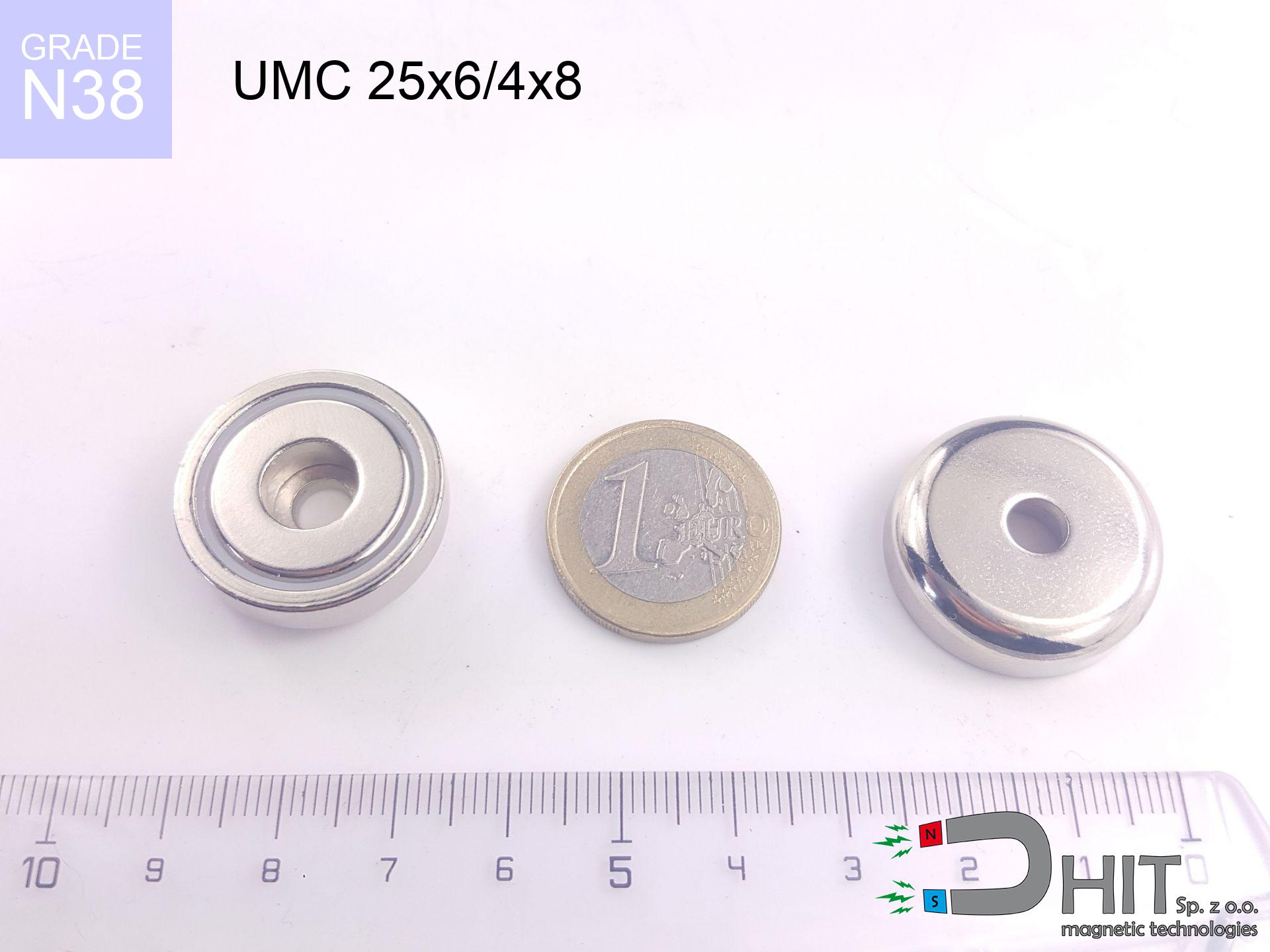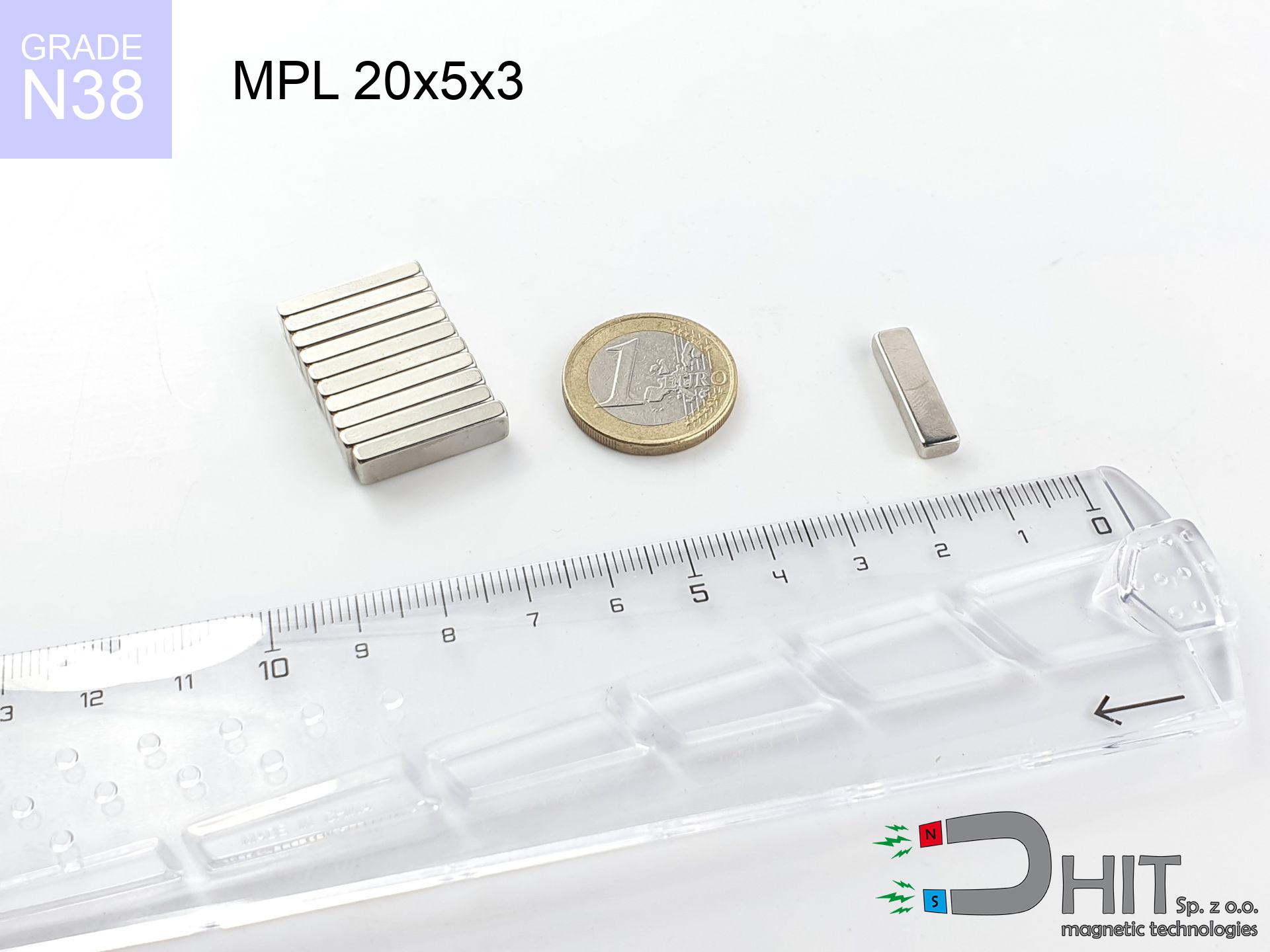UMH 36x8x46 [M6] / N38 - magnetic holder with hook
magnetic holder with hook
Catalog no 310428
GTIN/EAN: 5906301814573
Diameter Ø
36 mm [±1 mm]
Height
46 mm [±1 mm]
Height
8 mm [±1 mm]
Weight
65 g
Magnetization Direction
↑ axial
Load capacity
43.00 kg / 421.69 N
Coating
[NiCuNi] Nickel
26.64 ZŁ with VAT / pcs + price for transport
21.66 ZŁ net + 23% VAT / pcs
bulk discounts:
Need more?
Call us now
+48 888 99 98 98
alternatively let us know through
our online form
through our site.
Lifting power and structure of a magnet can be estimated with our
magnetic mass calculator.
Orders submitted before 14:00 will be dispatched today!
Technical of the product - UMH 36x8x46 [M6] / N38 - magnetic holder with hook
Specification / characteristics - UMH 36x8x46 [M6] / N38 - magnetic holder with hook
| properties | values |
|---|---|
| Cat. no. | 310428 |
| GTIN/EAN | 5906301814573 |
| Production/Distribution | Dhit sp. z o.o. |
| Country of origin | Poland / China / Germany |
| Customs code | 85059029 |
| Diameter Ø | 36 mm [±1 mm] |
| Height | 46 mm [±1 mm] |
| Height | 8 mm [±1 mm] |
| Weight | 65 g |
| Magnetization Direction | ↑ axial |
| Load capacity ~ ? | 43.00 kg / 421.69 N |
| Coating | [NiCuNi] Nickel |
| Manufacturing Tolerance | ±1 mm |
Magnetic properties of material N38
| properties | values | units |
|---|---|---|
| remenance Br [min. - max.] ? | 12.2-12.6 | kGs |
| remenance Br [min. - max.] ? | 1220-1260 | mT |
| coercivity bHc ? | 10.8-11.5 | kOe |
| coercivity bHc ? | 860-915 | kA/m |
| actual internal force iHc | ≥ 12 | kOe |
| actual internal force iHc | ≥ 955 | kA/m |
| energy density [min. - max.] ? | 36-38 | BH max MGOe |
| energy density [min. - max.] ? | 287-303 | BH max KJ/m |
| max. temperature ? | ≤ 80 | °C |
Physical properties of sintered neodymium magnets Nd2Fe14B at 20°C
| properties | values | units |
|---|---|---|
| Vickers hardness | ≥550 | Hv |
| Density | ≥7.4 | g/cm3 |
| Curie Temperature TC | 312 - 380 | °C |
| Curie Temperature TF | 593 - 716 | °F |
| Specific resistance | 150 | μΩ⋅cm |
| Bending strength | 250 | MPa |
| Compressive strength | 1000~1100 | MPa |
| Thermal expansion parallel (∥) to orientation (M) | (3-4) x 10-6 | °C-1 |
| Thermal expansion perpendicular (⊥) to orientation (M) | -(1-3) x 10-6 | °C-1 |
| Young's modulus | 1.7 x 104 | kg/mm² |
Chemical composition
| iron (Fe) | 64% – 68% |
| neodymium (Nd) | 29% – 32% |
| boron (B) | 1.1% – 1.2% |
| dysprosium (Dy) | 0.5% – 2.0% |
| coating (Ni-Cu-Ni) | < 0.05% |
Environmental data
| recyclability (EoL) | 100% |
| recycled raw materials | ~10% (pre-cons) |
| carbon footprint | low / zredukowany |
| waste code (EWC) | 16 02 16 |
View also products
Advantages as well as disadvantages of neodymium magnets.
Pros
- They have constant strength, and over around ten years their performance decreases symbolically – ~1% (according to theory),
- They are noted for resistance to demagnetization induced by external disturbances,
- By applying a reflective layer of nickel, the element acquires an aesthetic look,
- Magnets are distinguished by exceptionally strong magnetic induction on the surface,
- Made from properly selected components, these magnets show impressive resistance to high heat, enabling them to function (depending on their shape) at temperatures up to 230°C and above...
- Possibility of custom shaping as well as adjusting to specific requirements,
- Key role in high-tech industry – they are commonly used in computer drives, motor assemblies, medical equipment, as well as modern systems.
- Relatively small size with high pulling force – neodymium magnets offer high power in compact dimensions, which allows their use in small systems
Limitations
- At strong impacts they can crack, therefore we recommend placing them in steel cases. A metal housing provides additional protection against damage and increases the magnet's durability.
- We warn that neodymium magnets can reduce their power at high temperatures. To prevent this, we suggest our specialized [AH] magnets, which work effectively even at 230°C.
- When exposed to humidity, magnets usually rust. To use them in conditions outside, it is recommended to use protective magnets, such as those in rubber or plastics, which secure oxidation as well as corrosion.
- We suggest casing - magnetic mount, due to difficulties in producing threads inside the magnet and complicated forms.
- Potential hazard to health – tiny shards of magnets can be dangerous, in case of ingestion, which is particularly important in the context of child safety. It is also worth noting that small elements of these products can disrupt the diagnostic process medical in case of swallowing.
- Due to expensive raw materials, their price is higher than average,
Lifting parameters
Maximum holding power of the magnet – what affects it?
- using a plate made of mild steel, functioning as a circuit closing element
- possessing a massiveness of minimum 10 mm to ensure full flux closure
- with an ideally smooth contact surface
- without the slightest air gap between the magnet and steel
- for force applied at a right angle (pull-off, not shear)
- at temperature approx. 20 degrees Celsius
Key elements affecting lifting force
- Air gap (betwixt the magnet and the metal), since even a microscopic clearance (e.g. 0.5 mm) can cause a reduction in force by up to 50% (this also applies to varnish, rust or dirt).
- Pull-off angle – remember that the magnet has greatest strength perpendicularly. Under sliding down, the capacity drops drastically, often to levels of 20-30% of the nominal value.
- Element thickness – for full efficiency, the steel must be sufficiently thick. Thin sheet restricts the attraction force (the magnet "punches through" it).
- Material composition – different alloys reacts the same. Alloy additives worsen the interaction with the magnet.
- Surface finish – full contact is possible only on polished steel. Any scratches and bumps create air cushions, weakening the magnet.
- Heat – neodymium magnets have a negative temperature coefficient. When it is hot they are weaker, and at low temperatures they can be stronger (up to a certain limit).
Lifting capacity was determined using a smooth steel plate of optimal thickness (min. 20 mm), under perpendicular pulling force, in contrast under parallel forces the lifting capacity is smaller. Moreover, even a small distance between the magnet and the plate reduces the lifting capacity.
Safety rules for work with neodymium magnets
Fire warning
Machining of neodymium magnets poses a fire hazard. Neodymium dust oxidizes rapidly with oxygen and is difficult to extinguish.
Safe operation
Before use, check safety instructions. Uncontrolled attraction can destroy the magnet or injure your hand. Think ahead.
Magnetic media
Very strong magnetic fields can corrupt files on payment cards, HDDs, and other magnetic media. Keep a distance of min. 10 cm.
Warning for heart patients
Warning for patients: Strong magnetic fields disrupt electronics. Keep at least 30 cm distance or ask another person to handle the magnets.
This is not a toy
Only for adults. Small elements pose a choking risk, leading to severe trauma. Store out of reach of kids and pets.
Maximum temperature
Regular neodymium magnets (grade N) lose magnetization when the temperature surpasses 80°C. The loss of strength is permanent.
GPS and phone interference
Navigation devices and smartphones are extremely susceptible to magnetism. Direct contact with a powerful NdFeB magnet can permanently damage the internal compass in your phone.
Avoid contact if allergic
Certain individuals experience a contact allergy to Ni, which is the standard coating for NdFeB magnets. Prolonged contact may cause skin redness. We recommend wear protective gloves.
Physical harm
Pinching hazard: The attraction force is so great that it can cause blood blisters, pinching, and broken bones. Use thick gloves.
Fragile material
Watch out for shards. Magnets can fracture upon uncontrolled impact, ejecting sharp fragments into the air. We recommend safety glasses.

![Magnet with hook UMH 36x8x46 [M6] / N38 Magnet with hook UMH 36x8x46 [M6] / N38](https://cdn3.dhit.pl/graphics/banners/magnet.webp)
![UMH 36x8x46 [M6] / N38 - magnetic holder with hook](https://cdn3.dhit.pl/graphics/products/umh-36x8x46-m6-wim.jpg)
![UMH 36x8x46 [M6] / N38 - magnetic holder with hook - ujęcie 2](https://cdn3.dhit.pl/graphics/products/umh-36x8x46-m6-wum.jpg)
![UMH 36x8x46 [M6] / N38 - magnetic holder with hook - ujęcie 3](https://cdn3.dhit.pl/graphics/products/umh-36x8x46-m6-jun.jpg)





